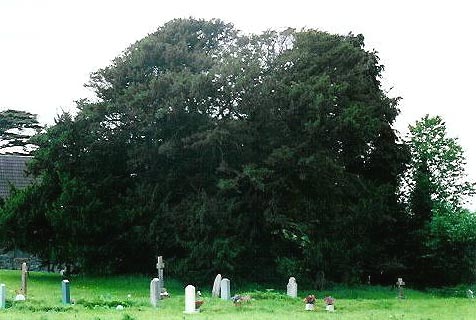The Ancient Yew of Ashbrittle
by Tracy Kramer
A series of country lanes winding through the heart of the English county of Somerset lead to the village of Ashbrittle. This small village holds an ancient treasure in its churchyard: a 3000 year old example of the English Yew, Taxus baccata. The tree was mature when Stonehenge was in use, making the 15th century church near where it grows a youngster in comparison. As a plaque near the tree declares, "Generations of local people have cherished this tree, one of the oldest living things in Britain."

It is impossible for a visitor to the Church of St. John the Baptist to miss the Ashbrittle Yew. With a girth of 40 feet and a vast canopy that arches over you as you approach it, the tree invites you to stop and gaze upon its lichen-covered branches, many of which nearly touch the ground, and its ancient, gnarled trunks cushioned by the lush mound of vegetation from which they grow. The tree has a hollow central trunk, with six smaller ones surrounding it. This distinctive form may have arisen long ago as the tree repaired itself after damage or infection in its original trunk.
Yew trees often regenerate themselves in this way and, in fact, have a bit of a reputation for immortality because of it. The heartwood of ancient yews is sometimes eaten away by fungi which leave the tree hollow but much more resilient against wind and storms. Any heavy branches that droop to the ground will eventually root themselves there. If disease causes the central trunk to split the segments of trunk can also root and create a ring of new trees.
The residents of Ashbrittle know they have a special tree in their village. In 1998-99 the Ashbrittle Yew Tree Project saw local people celebrate their ancient tree. Local people designed an information plaque which stands in front of the tree, leaded panels for the church and a brass pavior that lies in the path leading to the tree. The Ashbrittle Yew was also named one of the "Fifty Great British Trees" chosen to mark the Queen's Golden Jubilee.
Many stories surround the Ashbrittle Yew. The mound beneath the tree is thought by many to be Bronze Age and a pre-Roman chief is said to be buried there. According to local legend, the church was built on a druidic circle near which battles between Celts and invading Roman soldiers took place, and the heads of fallen Roman soldiers were brought triumphantly back here to be buried.
Indeed, yew trees were very important to the Celts. The yew occupied the most important point in their "tree calendar," the autumn festival of Samhain. This festival marked the end of the Celtic year. The seeming immortality of the yew represented the cycle of change and regeneration that the Celts saw in all forms of life. Many Christian churches were later built near yews, continuing the association with ceremony and worship. A sprig of yew is still sometimes placed on coffins as a symbol of renewal and resurrection.
The bark, stems, needles and seeds of the yew are poisonous, although birds can eat the vibrant berries without digesting the seed. This dangerous side of the yew has led some to call it the "tree of death" and stories abound in many cultures of people being poisoned, either deliberately or accidentally, by ingesting some of the yew's mysterious poison. However, the very substance that makes the yew deadly can also help save lives. The anti-cancer drug Taxol is derived from the poison. The discovery of yew as an important botanical source of cancer treatments continues the tree's strong associations with life and regeneration and provides one more reason to treasure these amazing trees.
On visiting the Ashbrittle Yew it is easy to appreciate the reverence with which yews have been regarded through the centuries. In 1813 William Wordsworth wrote a poem about the Lorton Yew in the North of England, but he could just as well have penned the words in homage to the great yew at Ashbrittle, so well do they fit:
"Of vast circumference and gloom profound
This solitary Tree! a living thing
Produced too slowly ever for decay;
Of form and aspect too magnificent
To be destroyed."
The Ashbrittle Yew is in the churchyard of the church of St. John the Baptist in the village of Ashbrittle, Somerset. Ashbrittle is 10 miles west of Taunton. From Junction 26 of the M5, join the A38 going south. Follow this road for approximately four miles, then follow signs to Ashbrittle.
More Information:
We regret that we no longer have the resources to maintain up-to-date links and/or hours and pricing details for the various sites and attractions listed on this website. For more information about the location(s) listed above, please use your favorite search engine or visit Wikipedia.
Tracy Kramer, a native of Tucson, Arizona, studied English at Kenyon College in Ohio. She now lives and works in Bristol, England, where she enjoys writing about organic growing, sustainable living and the British countryside.
Article and photo © 2003 Tracy Kramer
| 